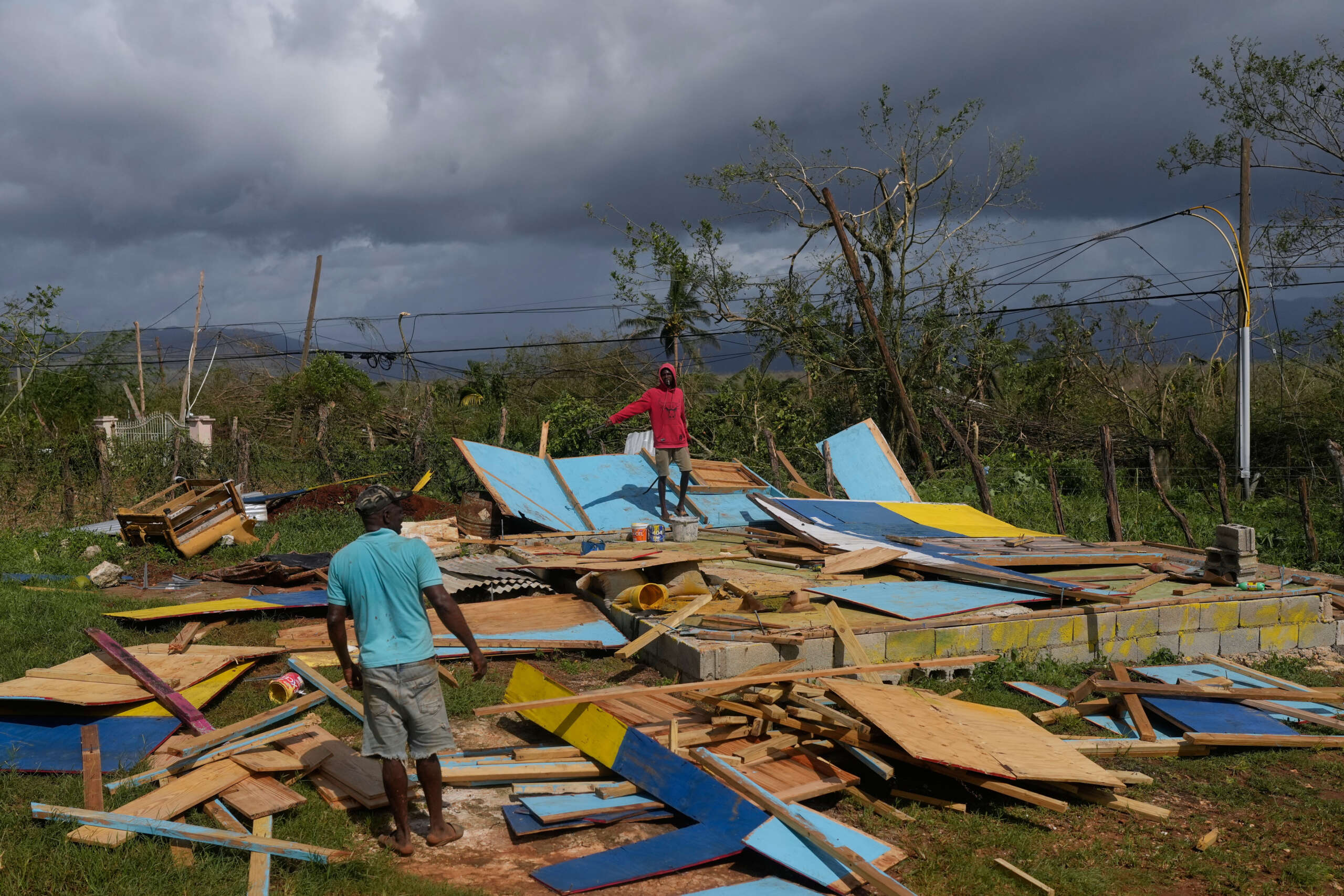Copyright caymancompass

Nearly half a million people were left without power and thousands of people are in emergency shelters after Jamaica was hit by one of the strongest storms in its history. The Category 5 Hurricane Melissa hit the south coast of the island on Tuesday 28 Oct. and caused widespread damage across the country, knocking out power supplies, turning roads into rivers, ripping the roofs off houses and sweeping buildings away in landslides. Emergency housing More than 25,000 people are currently in emergency shelters with more arriving every hour as people make their way to safety. Hospitals, schools and vehicles were damaged across the country, with western Jamaica bearing the brunt of the storm in areas including Saint Elizabeth, Westmoreland, Saint James and Hanover, plus more central areas such as Manchester and Clarendon. Hours after the all-clear was sounded, reports were coming in of the destruction caused by the storm. Homes in the community of Phoenix in Hanover, at the northwestern coast of Jamaica, were reported as being completely destroyed, while there were reports of serious devastation in Saint James, where the hurricane left the island, with residents being trapped by rising floodwaters. Jamaica’s capital, Kingston, is understood to have been relatively unscathed and power was expected to be restored there relatively quickly. Storm impact At its peak, the hurricane recorded winds of 298 km/h (185 mph) and caused more than three-quarters of the island to be without power. Jamaica’s prime minister Andrew Holness declared the island a “disaster area” late on Tuesday evening and warned of the “devastating impacts” of the storm. The full extent of the damage is still being assessed, with houses and communities in parts of the country such as in Morant Bay, Cave Valley, Clarendon and Spalding understood to be at least partially submerged. Gerda Henry, a former Cayman Islands resident, now living in Clarendon, said her neighbourhood suffered major damage, with roads and homes being carried away in landslides and roofs being blown off in the devastating hurricane winds. Her own home was flooded by water coming through the windows and doors. “There has been some large damage,” she said, “but one thing I’m grateful to God for is I am alive.” She said power was out all around her and electricity poles could be seen lying across roads. Phone reception down Camalee Thomas who works as a cleaner in Cayman, said she had been frantically trying to reach her mother and daughter and wider family in Jamaica without success on Wednesday. “All the cell towers are down so no-one can call and we can’t reach anyone,” she said. Thomas is from St Elizabeth and her home is close to where the storm made landfall at Treasure Beach. She last spoke to her seven-year-old daughter the day before the storm hit and has heard nothing since. She followed the news via TikTok throughout the night and into Wednesday, watching alarming videos of water running in the roads and roofs ripped off houses. “Our area was severely damaged. According to what I hear 90 percent of buildings are without a roof. There has been a lot of flooding and a lot of resorts mashed up completely. “I have been so stressed I can’t sleep. I’ve been trying to reach them over and over again. It has been terrifying. We don’t know if they’re safe. We don’t know if they are wet, we don’t know if they are warm, we don’t know if the kids are okay. We don’t know if they have food. We don’t know if they are totally flooded. We basically just don’t know anything at the moment.” Prime Minister Holness, government ministers, relief organisations and the Jamaica Defence Force were surveying the island by air on Tuesday to assess the damage. The all-clear was sounded on Tuesday morning once the hurricane had moved northwards off the island, giving the green light to go out to essential service providers to go out to assess and repair the damage. National agencies including the energy supplier Jamaica Public Service, National Water Commission, National Works Agency, telecommunications providers and other critical supplies were told to start work straightaway to restore power, water and communication networks. Retailers such as supermarkets, gas stations and pharmacies were told to reopen where possible, especially in the less affected areas, so that communities could access to essential food and services. Crocodile danger Residents were told to take care, especially in areas where downed power lines, debris or flooding may still pose risks. In some areas, officials warned people to be on the alert for crocodiles which might have been swept from their usual habitats. “Rising water levels in rivers, gullies, and swamps could cause crocodiles to move into residential areas,” the South East Regional Health Authority said in a statement online. “Residents living near these areas are therefore advised to remain vigilant and avoid flood-waters.” Government ministers promised that shelters would remain open as long as they were needed and that no-one would be turned away. Heavy rain was expected to continue across many parts of the country, particularly in the north and an alert was issued about the possibility of flash flooding. Melissa not done After leaving Jamaica, Hurricane Melissa passed through Cuba, making landfall near Santiago de Cuba – the country’s second-largest city – early Wednesday morning as a Category 3 major hurricane. Initial reports indicate Santiago de Cuba experienced significant damage, particularly as a result of flooding. Although the storm weakened during its crossing over land in Cuba, Melissa still emerged as a Category 2 hurricane and passed through the southern Bahamas on Wednesday. The storm is now expected to pass just west of Bermuda as a Category 1 or 2 hurricane early Friday morning before transitioning to an extratropical storm on Saturday, when it will pass near Newfoundland, Canada. International response Jamaica’s national response was being coordinated by the Office of Disaster Preparedness and Emergency Management. The initial damage assessment phase, which began on Tuesday, will identify the hardest hit areas to determine where urgent response and relief operations are needed most to reach all those impacted by the storm. On Tuesday afternoon, the Jamaican government launched the Support Jamaica online platform to mobilise support, channel relief and coordinate recovery efforts. People can donate money towards disaster relief through the portal, which also provides emergency updates and reporting tools for flooding or storm damage. In Cayman, Hazard Management Cayman Islands was working with ODPEM and the Caribbean Disaster Emergency Management Agency as well as NGOs, including the Cayman Islands Red Cross, Rotary, Kiwanis, Lions Club, R3 Cayman Foundation and the Cayman Ministers’ Association, to co-ordinate the national relief response. A relief flight with supplies is expected to take off for Jamaica Thursday morning. Responding to a request from Jamaica, Cayman Islands Governor Jane Owen granted permission for the Jamaica Defence Force to use Owen Roberts International Airport as a base from which to map the damage as well as in the delivery of critical relief supplies for the emergency response. Permission has also been granted for the United States to also use Cayman as a forward operating base for four chinooks and six black hawk helicopters to support the Jamaica humanitarian relief efforts. The Jamaican government said it hoped to reopen Kingston’s Norman Manley international airport on Thursday for relief flights and was also considering using the Ian Fleming airport in Ochos Rios as an alternative. It was not known on Tuesday morning what damage there had been to Sangster International Airport at Montego Bay. Disaster relief is also being provided by Royal Navy warship HMS Trent, while the US Department of State has said sent a regional disaster assistance response team and search and rescue team to help operations on the ground. Cayman’s relief efforts McKeeva Bush, who was leader of the government when Hurricane Ivan hit Grand Cayman, urged Caymanians to stand beside their neighbours. Bush is chair of the private sector Humanitarian Relief Committee and is working with figureheads in the Jamaican community in Cayman to organise sustained support for the stricken island. A meeting has been organised for 7pm Thursday at the Tortuga Rum headquarters on North Sound Road. “We are encouraging all community members, churches, service clubs, business owners, and anyone who wishes to assist to please attend,” a community announcement from the organization stated. “This meeting will provide updates on the relief efforts, donation procedures, and ways you can get involved as we work together to support our Jamaican family. Bush emphasised how Jamaica had come to the aid of Cayman after Ivan. “We know what they are going through because we have been through it,” he said. “It took many hands to rebuild this country after Hurricane Ivan. It was not just us alone.” He said Jamaican contractors and aid organizations as well as churches and investors had been part of the rebuild. “We sometimes forget how fortunate we are in Cayman, but we have neighbours in the region who are much worse off than us and needs assistance and this committee is here to help.” Other support efforts include: The Cayman Islands Red Cross launched its appeal for financial support to help those affected by Hurricane Melissa. Cayman’s Red Cross is working with the Jamaican Red Cross, the Cayman Islands Government and other key partners to co-ordinate relief efforts. The HSA Blood Bank issued an urgent request for emergency blood to be sent to Jamaica. People can register to give blood at www.bloodbank.ky The Adventist Development and Relief Agency (ADRA) is collecting relief items such as food, sanitary supplies and water which can be dropped off at the George Town Seventh Day Adventist Church. Funds can be donated via Adracayman.org US-based Catholic Relief Services is seeking donations to support families in Haiti and Jamaica via its Latin America and Caribbean Emergency Fund.



